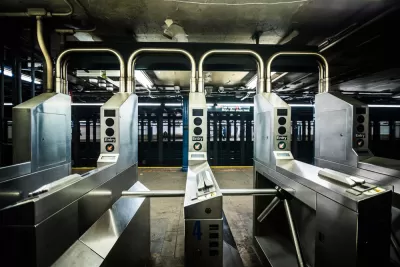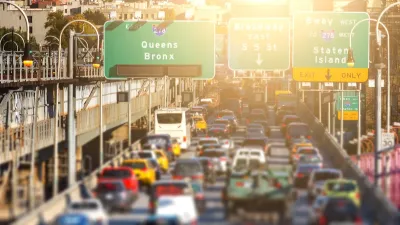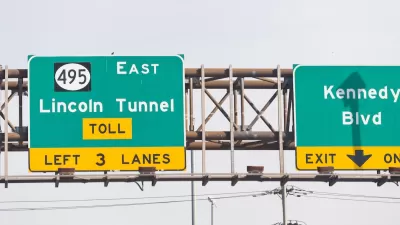In the continuing debate over congestion pricing in New York, Adele Peters asks if transit advocates are stopping short of what they should be asking for: free transit for all of New York.

It's been a rough year for the MTA. Between service failures and falling ridership, many are looking for a way to buoy public transit in New York. Some transit proponents have argued for congestion pricing, but Mayor Bill de Blasio continues to oppose the idea.
"But a report at the time, commissioned by mass transit advocate Theodore Kheel, suggested that a fee on drivers would not only reduce traffic and save the city billions by regaining the productivity of people previously stuck in gridlock, but would be able to pay for free public transportation for everyone else," Adele Peters writes for Fast Company. This is beyond what some have asked for. "The fees could help repair and upgrade the city’s struggling subway system. The idea of free public transit is less likely to ever happen," Peters writes. But that is what Mayor Bloomberg described wanting when he discussed the idea during his term.
For his part, de Blasio suggests funds for the MTA could come from a "millionaire's tax" that would subsidize transit passes for those who can’t afford tickets, Peters reports. But this system would do nothing to curb traffic or creates incentives for transit before the improvements can be made. Peters argues that transit's role will be just as important in the future: "Even if cars are shared, electric, and self-driving, subways and buses still have advantages, including keeping roads less congested. Cities will need to find ways to make those traditional services competitive, and that might eventually mean lower–or even free–fares."
FULL STORY: Should Public Transit Be Free?

Study: Maui’s Plan to Convert Vacation Rentals to Long-Term Housing Could Cause Nearly $1 Billion Economic Loss
The plan would reduce visitor accommodation by 25,% resulting in 1,900 jobs lost.

North Texas Transit Leaders Tout Benefits of TOD for Growing Region
At a summit focused on transit-oriented development, policymakers discussed how North Texas’ expanded light rail system can serve as a tool for economic growth.

Why Should We Subsidize Public Transportation?
Many public transit agencies face financial stress due to rising costs, declining fare revenue, and declining subsidies. Transit advocates must provide a strong business case for increasing public transit funding.

How to Make US Trains Faster
Changes to boarding platforms and a switch to electric trains could improve U.S. passenger rail service without the added cost of high-speed rail.

Columbia’s Revitalized ‘Loop’ Is a Hub for Local Entrepreneurs
A focus on small businesses is helping a commercial corridor in Columbia, Missouri thrive.

Invasive Insect Threatens Minnesota’s Ash Forests
The Emerald Ash Borer is a rapidly spreading invasive pest threatening Minnesota’s ash trees, and homeowners are encouraged to plant diverse replacement species, avoid moving ash firewood, and monitor for signs of infestation.
Urban Design for Planners 1: Software Tools
This six-course series explores essential urban design concepts using open source software and equips planners with the tools they need to participate fully in the urban design process.
Planning for Universal Design
Learn the tools for implementing Universal Design in planning regulations.
Ascent Environmental
Borough of Carlisle
Institute for Housing and Urban Development Studies (IHS)
City of Grandview
Harvard GSD Executive Education
Toledo-Lucas County Plan Commissions
Salt Lake City
NYU Wagner Graduate School of Public Service




























